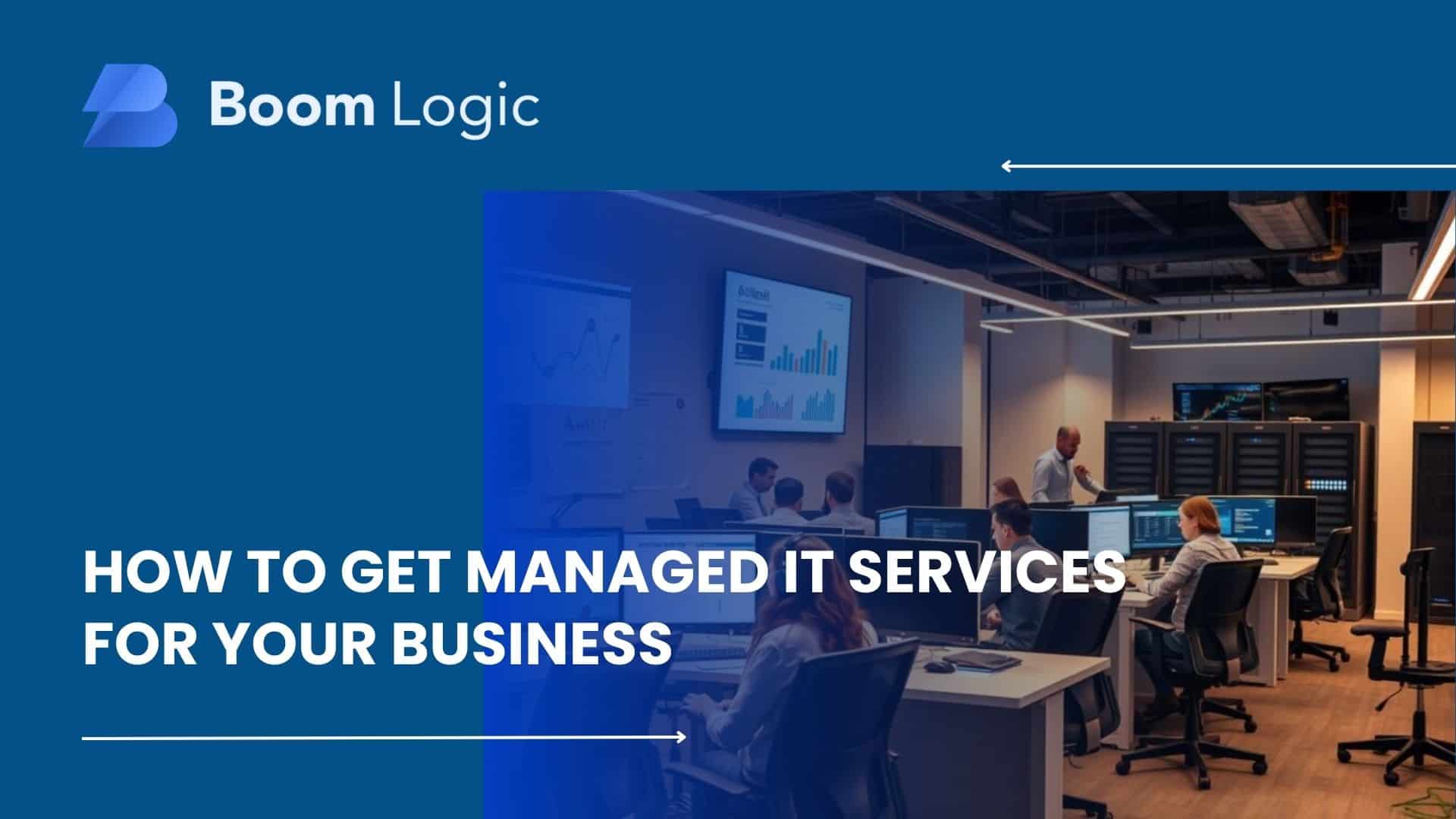You work hard to run your company. Technology should help, not slow you down. At Boom Logic, we act as your local team in Los Angeles, Pasadena, and Burbank to guide a clear path toward reliable managed services.
Many organizations choose MSPs for steady support, cloud planning, and cybersecurity. In 2022, most small firms used or considered a provider, with many opting for co‑managed or fully managed models. Proactive programs reduce downtime and risk, while break‑fix reacts after problems surface.
We focus on mapping your needs to outcomes first. That means planning, monitoring, backups, vendor coordination, and reporting under one accountable provider. You gain faster onsite response when needed and remote coverage around the clock.
Key Takeaways
- A local partner gives faster response and onsite support when matters are urgent.
- Proactive management limits outages and cyber risk better than break‑fix.
- Modern programs blend strategy, security, cloud, and daily support under one roof.
- Co‑managed options extend your team without forcing a full overhaul.
- Subscriptions and service levels create predictability for technology and budget.
Understanding managed IT services in today’s landscape
Technology should simplify daily work, not add more tasks for your team. In Los Angeles, Pasadena, and Burbank, a clear service model covers both routine operations and long‑term upgrades. That means one partner handling everyday fixes and strategic planning.

What coverage looks like—from monitoring to cloud
An msp runs remote monitoring for servers, network, and cloud platforms. You get 24/7 oversight for hardware and infrastructure, plus user support for routine issues.
Why proactive support outperforms break‑fix
Proactive models detect faults early, patch systems, and tune configurations. This approach cuts downtime and reduces recurring problems that cost time and revenue.
- Round‑the‑clock monitoring and quick incident response.
- Managed cybersecurity, threat detection, and incident playbooks.
- Cloud configuration, cost control, and performance tuning.
- Clear SLAs, regular reporting, and unified operational processes.
Working with local providers means consistent standards across sites. You retain focused expertise across systems, infrastructure, and cloud without heavy hiring or training.
How to get managed it services
Begin by translating leadership goals into measurable technology outcomes. This step keeps decisions tied to revenue, uptime, and user productivity rather than a pile of tools.

Mapping business goals to IT outcomes
List your top business goals and critical workflows. Then map each goal to clear IT outcomes such as faster ticket resolution, fewer outages, or secure remote access.
Document priorities and budget limits so strategic planning stays practical and repeatable.
Deciding between fully managed and co managed support
Evaluate current skills, coverage gaps, and growth plans. Many organizations choose a full transfer of daily tasks to an msp for speed and scale.
Others pick a co‑managed model to extend an internal team where they need help most. Both paths require a service provider that documents systems, policies, and budgets.
- Define business goals, then build a prioritized roadmap.
- Match needs by function: end‑user support, monitoring, cybersecurity, cloud, backups.
- Set clear communication, change management, and mutual responsibilities with your provider.
Assessing your current environment before you buy
Start with a clear picture of what runs your workplace and where weak links live. We perform structured discovery across Los Angeles, Pasadena, and Burbank so you don’t rely on guesswork.
Inventorying systems, users, and critical workflows
Document systems, licensing, vendor contacts, and an accurate network diagram up front. This makes troubleshooting faster and changes safer.
- You receive a thorough inventory of systems, users, devices, and integrations so dependencies are clear.
- Critical workflows and data paths are mapped, not just asset lists, so you protect what drives value.
- Recurring problems—slow endpoints, aging hardware, or shadow IT—are identified and prioritized.

Identifying risk hotspots: security, downtime, and compliance
Monitoring tools and assessments reveal potential failures and signs of cyber attacks. You also get insights into patching, access controls, and encryption gaps.
- Review compliance needs and reasonable safeguards with documented, auditable controls.
- Receive baseline metrics that highlight instability and performance anomalies predicting outages.
- Leave with an authoritative system diagram and a fact-based plan showing where to focus investment first.
For an example of local discovery and documented outcomes, see our Pasadena profile at Pasadena discovery summary.
Strategic IT planning that aligns with your growth
A focused IT roadmap keeps projects aligned with budget cycles and growth targets. We act as a practical planning partner for businesses in Los Angeles, Pasadena, and Burbank, bringing a steady cadence to reviews and budgets.
Building a practical roadmap and budget cycle
Use a vCIO-style approach to link technology investments with business goals. Set quarterly reviews that map initiatives to growth milestones and operational targets.
Document plans and budgets yearly, then update priorities in the living roadmap. This keeps cloud moves, upgrades, and cost sequencing predictable while improving resilience.
- Quarterly review rhythm with measurable outcomes for reduced incidents and faster onboarding.
- Budget cycles that sequence upgrades and cloud changes to control cost and risk.
- Clear provider roles for execution, reporting, and change control so projects move forward.
- Paced modernization that matches capacity, security, and compliance needs for your organization.
Model scenarios and keep a prioritized backlog so leadership sees rationale, timelines, and expected benefits. That clarity helps your provider and your msp deliver solutions that matter.
Security first approach to managed services
Effective protection depends on small habits that stop big breaches before they start. Your organization benefits when policy, training, and daily operations line up around clear, practical defenses.

Training policies and password management that actually work
Make training role-based and short. Focus on phishing, safe sharing, and incident reporting so employees retain essentials.
Use centralized password management and require MFA. These steps cut credential theft while keeping user workflows simple.
Threat monitoring, patching, and endpoint protection
Keep endpoint protection active and patch schedules regular. Monitor logs for anomalies and remediate vulnerabilities quickly.
Combine antivirus, firewall oversight, and dark web checks for a layered defense around data and systems.
Legal exposure and reasonable safeguards
Document controls, runbooks, and changes so audits show due care. Encryption for data at rest and in transit reduces legal risk.
Define incident roles and test response plans so your organization acts fast and consistently when incidents occur.
- Role-based training that builds a security culture.
- Password management and MFA that improve behavior without hindering work.
- Endpoint protection, timely patching, and documented controls for audits.
Always on monitoring and support that reduce downtime
Immediate visibility across cloud, servers, and endpoints lowers the risk of surprise failures. Our rostered staff in Los Angeles, Pasadena, and Burbank stands ready day and night. That means alerts reach a qualified engineer fast, and incidents are routed using clear escalation paths.

24/7 alerting for servers, network, cloud and devices
You receive continuous monitoring that flags anomalies and sends context-rich tickets. This reduces downtime by fixing capacity, hardware, or configuration issues early.
- Real-time monitoring that routes alerts to the right engineer without delay.
- Consistent support at any hour with documented SLAs and escalation paths.
- Unified tools and processes across infrastructure so alerts are actionable.
- Transparent incident status and trend baselines that prevent repeat failures.
- Remote remediation combined with local onsite response when hands are required.
- Qualified staff assess and respond to alerts for servers, workstations, cloud, and devices.
- Incident metrics link outcomes to business impact for clearer ROI.
- Your provider maintains tooling and runbooks for faster, repeatable resolution.
Cloud management and modernization without the chaos
A pragmatic cloud plan keeps critical apps running while you modernize in stages. You avoid big cutovers and test each phase for reliable outcomes. This reduces interruption across Los Angeles, Pasadena, and Burbank.
Choosing workloads for public, private, or hybrid models
Evaluate application needs, data residency, and integration risk. Map each workload to the model that balances latency, compliance, and security.
Plan migrations in phased waves. Validate performance at every step and pause if adjustments are needed.
Ongoing optimization: performance, cost, and compliance
Continuous management includes monitoring, right‑sizing, tagging, and cost reviews. You keep resources aligned with demand and avoid wasteful spend.
- Enforce security baselines and automated compliance checks.
- Implement resilient architectures with backups and recovery processes.
- Standardize configurations and tag assets for governance and reporting.
- Create feedback loops from operations back into architecture for steady improvement.
- Align providers and internal teams on shared runbooks so platforms don’t drift.
Backup and disaster recovery that goes beyond a device
Resilient backups and practiced procedures stop outages from becoming crises. You need plans that cover people, network, power, and critical apps—not only file restores.
RPO, RTO targets and layered backups on site and cloud
Define RPO and RTO by workload so recovery matches business priorities. Some workloads need minutes; others tolerate longer windows.
Use layered backups: fast on-site copies for quick restores and cloud copies for geographic resilience. Add redundant internet paths and emergency power for continuity.
Testing, documentation and emergency operations
Document a disaster plan with roles, communications, and step-by-step runbooks. Your provider should own the testing cadence and keep evidence of drills.
- Monitor backups and validate test restores with real tools and scenarios.
- Run tabletop exercises and full failovers to reduce downtime and confirm staff performance.
- Secure backup data and access paths to prevent tampering and ensure integrity.
- Standardize recovery procedures so teams execute quickly and consistently.
Managing mobile devices securely wherever your users work
Managing devices for a modern workforce means balancing convenience with clear safeguards. Your mobile program should keep employees productive while protecting company data and privacy.
Provisioning, encryption and remote wipe
Use a device management platform that automates setup and secure defaults for phones, tablets, and laptops. Enforce encryption and screen‑lock policies so lost devices won’t expose data.

- Standardize provisioning so new devices arrive ready and compliant.
- Enable remote wipe and selective wipe to remove company content without erasing personal files when appropriate.
- Streamline app and email access with least‑privilege controls that scale across teams.
- Monitor device posture and auto‑remediate drift to keep compliance steady.
- Coordinate inventory with procurement and offboarding, and provide fast user support wherever employees are.
Align device lifecycle management with update schedules and backups. That keeps security tight and reduces downtime while your provider handles routine management tasks.
Vendor management that saves your team time
When multiple providers point fingers, projects stall and users wait. You need a single partner who coordinates vendors and clears roadblocks fast.
We act as that partner — contacting ISPs, telephony firms, software vendors, and security tool teams on your behalf. That reduces wasted hours and keeps work moving.
One partner to coordinate providers and resolve conflicts
Centralized management means your company has one accountable provider for escalations. Your team stops chasing answers and starts using time for priorities.
- You centralize accountability with a partner who owns escalations across providers.
- You eliminate finger‑pointing by having a single team diagnose problems end to end.
- You reclaim time as we handle tickets, scheduling, and third‑party follow-ups.
- Service levels and trend tracking inform renewals and contract improvements.
- Access changes and cross‑system updates are coordinated for fast, consistent results.
- Documentation captures issues, resolutions, and dependency maps for audits.
- Periodic value reviews reveal consolidation chances and better commercial terms.
- Operational drag from multi‑vendor problems drops, and projects move forward.
Pricing models and what they mean for your organization
Pricing choices shape accountability, scalability, and what’s covered under support. Each model highlights different tradeoffs between predictability, flexibility, and vendor effort.
Per device, per user, tiered, and à la carte
Per-device pricing works well when endpoints are stable and predictable. You pay by each physical or virtual unit and gain clarity on hardware count.
Per-user pricing covers multi-device employees and simplifies licensing across laptops, phones, and tablets. It scales with headcount rather than inventory.
Tiered plans bundle features by level. They offer simple choices but may include unused items. À la carte picks let you add specific offerings, yet increase administration.
Value-based engagements and long-term scalability
Value-based pricing ties cost to outcomes like uptime, response, or productivity gains. This aligns incentives but needs clear metrics and reporting.
- Compare models for scope, accountability, and scalability as your environment changes.
- Match per-device for stable footprints and per-user for mobile workforces.
- Weigh tiered simplicity against à la carte flexibility and overhead.
- Prefer value-based contracts when SLAs and measurable outcomes are clear.
- Ensure SLAs, reporting, and change processes are explicit so your provider can scale with your organization.
Service levels reporting and accountability you can trust
Clear accountability starts with measurable promises and timely updates from your provider. You should see concise reports that link work to business outcomes and show real progress.

Setting SLAs, response times, and meaningful metrics
Establish SLAs that match business impact rather than generic windows. Pick metrics that matter: mean time to resolution, incident recurrence, patch latency, and recovery times.
Agree on response tiers for urgent, high, and low incidents. That keeps priorities aligned during outages and normal work.
Security and compliance considerations in contracts
Include explicit security commitments and audit-ready documentation in the contract. Define roles, access controls, and evidence trails for compliance reviews.
- Require evidence-driven reporting that ties services to executive outcomes.
- Define change control, communication cadence, and review cycles for projects and incidents.
- Verify the msp’s capacity to scale coverage, hours, and expertise as your footprint grows.
- Confirm escalation paths into senior engineering and leadership for complex issues.
Working with Boom Logic in Los Angeles Pasadena and Burbank
Local presence matters when transitions must be smooth and predictable. Boom Logic brings a regional playbook that reduces disruption and speeds outcomes across Los Angeles, Pasadena, and Burbank.
Our local approach to onboarding and transition
We begin with discovery, documentation, and network diagrams. Access normalization follows so accounts and permissions are consistent.
Early wins focus on noisy alerts, recurring tickets, and critical patch backlogs. That builds momentum while we stabilize operations.
Co‑managed options that extend your in‑house team
If you prefer shared ownership, our co‑managed model fills gaps in coverage and specialty skills. You keep control of strategy while we provide operational depth.
- Structured kickoff: discovery, documentation, stabilization.
- Quick wins addressed early for immediate risk reduction.
- 90-day plan that hands over operations with minimal disruption.
- Co‑managed coverage for after‑hours support and niche skills.
- Regional onsite coverage backed by remote response and clear contact points.
You measure success with agreed milestones and visible risk reduction. That clarity helps your staff and our engineers collaborate efficiently.
Talk with Boom Logic about your managed IT needs
Plan a short, focused conversation that lets us match technical choices with your business goals. A single call helps us assess needs and outline next steps for companies in Los Angeles, Pasadena, and Burbank.
What to bring for an initial conversation: systems, goals, timelines
Bring a brief overview of systems, major applications, locations, and user counts. That snapshot speeds discovery and highlights immediate risk areas.
- Outline business goals and target timelines so we prioritize services that deliver early value.
- Share recent incidents or pain points to focus risk reduction and performance work.
- Note compliance needs and any upcoming audits so recommendations align with rules.
- Confirm who needs access to updates and reports during the engagement.
- Review current contracts and renewal dates to plan clean transitions.
- Prepare questions about coverage, escalation, and service boundaries to save time.
- Request an audit when you want a fact-based baseline for decisions and cost estimates.
- You leave the meeting with insights, draft next steps, and a short validation plan before committing time or budget.
When you connect, we tailor recommendations quickly by verifying scalability and flexibility from our provider playbook. Reach out and we will set a practical next step that fits your company timeline.
Conclusion
.
A focused partnership makes your technology a predictable asset, not a recurring burden.
Choose a provider that combines 24/7 monitoring, practical strategic planning, and clear SLAs. This lowers downtime, improves performance, and keeps security and backups current.
Many businesses prefer an experienced service provider or an msp so employees spend time on customers, not firefighting. Co‑managed and full transfer models both scale with your goals and budget.
When you pick a local partner like Boom Logic, you gain faster onsite response, measurable reporting, and accountability that aligns with business outcomes. Reach out for a concise review and a simple next step that fits your company timeline.


